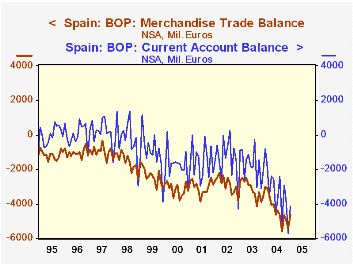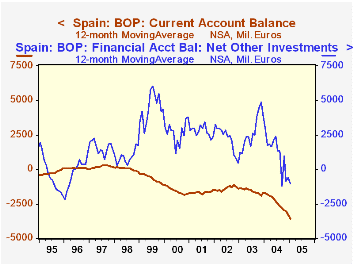 Global| Apr 15 2005
Global| Apr 15 2005Spanish Current Account Deficit Widens in January, Even as Financial Flows Seek Their Own Return
Summary
Spain's current account deteriorated significantly during 2004, and in January, which was reported today by the Bank of Spain, the deficit continued to widen from year-earlier amounts (see graph alongside). Much of this movement [...]

Spain's current account deteriorated significantly during 2004, and in January, which was reported today by the Bank of Spain, the deficit continued to widen from year-earlier amounts (see graph alongside).
Much of this movement occurred in merchandise trade, as might be expected. However, other current accounts also moved adversely, as evidenced in the table below. The surplus on services decreased, and the deficit on income increased considerably. Among services, the surplus on tourism, which rose from the mid-1990s through the middle of 2001, flattened subsequently, and during the last year it diminished as Spaniards traveled elsewhere, while outlays by tourists to Spain just held steady.
Conventional wisdom argues that the function of the financial accounts in the balance of payments is to "finance" the current account. But increasingly, as we have frequently mentioned for the US, the financial accounts evolve autonomously. For example, direct investment into Spain, which ran surpluses in 2002 and 2003, moved decisively into deficit last year.

Similarly with "other" investment, representing mainly bank deposit and lending activities, a surplus in the two earlier years shifted to a deficit position for 2004 and this continued in January. This last item in particular might be associated with the financial operations that facilitate trade flows. But it moved against the trade flows instead. Portfolio investment and payments through the Bank of Spain made the difference to "balance" the "balance of payments". This mix of payment types, however, highlights clearly that financial flows exert their own independent impact on international economic relations, serving a broader function than simply offsetting shipments of goods back and forth across national borders.
| SPAIN Balances, Mil. Euros |
Jan 2005 | Dec 2004 | Jan 2004 | Monthly Averages|||
|---|---|---|---|---|---|---|
| 2004 | 2003 | 2002 | ||||
| Current Account | -4155 | -5710 | -809 | -3295 | -1736 | -1407 |
| Merchandise | -4675 | -5403 | -2989 | -4324 | -3154 | -2884 |
| Services | 1431 | 1236 | 1292 | 2097 | 2272 | 2215 |
| Income | -1223 | -1715 | -640 | -1069 | -882 | -940 |
| Financial Account | 4680 | 3919 | 1673 | 3027 | 1470 | 1230 |
| "Private" Financial Flows = Sum of 3 Below | 3022 | 1072 | 8738 | 4040 | 1618 | 1342 |
| Direct Investment | -1170 | -1526 | -326 | -2157 | 166 | 389 |
| Portfolio Investment | 7861 | 8479 | 7597 | 6798 | -2506 | 474 |
| Other Investment | -3669 | -5881 | 1467 | -601 | 3958 | 479 |
Carol Stone, CBE
AuthorMore in Author Profile »Carol Stone, CBE came to Haver Analytics in 2003 following more than 35 years as a financial market economist at major Wall Street financial institutions, most especially Merrill Lynch and Nomura Securities. She had broad experience in analysis and forecasting of flow-of-funds accounts, the federal budget and Federal Reserve operations. At Nomura Securities, among other duties, she developed various indicator forecasting tools and edited a daily global publication produced in London and New York for readers in Tokyo. At Haver Analytics, Carol was a member of the Research Department, aiding database managers with research and documentation efforts, as well as posting commentary on select economic reports. In addition, she conducted Ways-of-the-World, a blog on economic issues for an Episcopal-Church-affiliated website, The Geranium Farm. During her career, Carol served as an officer of the Money Marketeers and the Downtown Economists Club. She had a PhD from NYU's Stern School of Business. She lived in Brooklyn, New York, and had a weekend home on Long Island.





